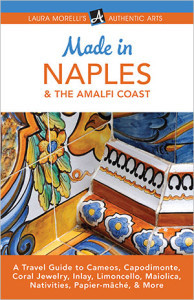Laura Morelli's Blog
October 1, 2018
Have you ever dreamt of being a Medici?
In past centuries, patrons supported their writers and artists by engaging them directly. They welcomed them into their homes and around their dinner tables. They made paintings, sculptures, buildings, and great works of literature possible. Without patronage, we may never have had the Sistine Chapel, the Mona Lisa, or countless other masterpieces. Together, these creators and their patrons made the world a better place.
Now, I’m not asking you to put me up in your guest room or cook me a meal (though I rarely turn down a good invitation). But what’s exciting about being a creator today is that technology allows us to work directly with people who want to support our work. Today, it’s easier than ever for you and I to work together to make the world a better place.
Here I am with the funerary mask of my dream patron, Lorenzo de Medici. Only, he’s… dead. Darn.
Today, I’m excited to announce that I’m partnering with Patreon to bring more great stories–both true and imagined–directly to you. You can support me for as little as $1 a month. And there are higher levels for those who want to receive cool extras.
It would mean the world to me if you would take a minute to watch this video and decide if becoming my patron is right for you. You don’t have to have a Medici budget. Even if each supporter contributes $1–less than a coffee a month–it shows that you value my work and want it to continue. Your contribution will help me bring you more of the art history and art historical fiction that you’ve been asking for.
I’d like to thank you by offering my latest work of fiction. The story is called “Little Bird,” and it’s set in medieval Siena. There’s a renowned fresco painter, the famous Palio horse race, the plague, and, at the center of the drama, a young girl with a remarkable gift. I can’t wait to share this new short story with you, and to hear what you think.
P.S. My new story, “Little Bird,” is not for sale anywhere. It’s exclusively available as a thank you to my new Patreon supporters at any level, and available to download directly to your e-reader via Patreon. Learn more.
The post Have you ever dreamt of being a Medici? appeared first on Laura Morelli: Art History, Art Historical Fiction, Authentic Travel.
September 27, 2018
Confessions of Venice Addicts
Hello, friends and readers!
My friend Kathleen Ann Gonzalez is a pure Venetophile. She is an English teacher from California who spends a lot of time in Venice, and chronicles her travels and fascinating Venetian research topics on her blog, Seductive Venice. I recommend the blog if you love reading about unique and off-the-beaten-track Venetian subjects. (Kathleen has also been a guest on my own blog; click here to read the interview.)
Earlier this year Kathleen asked me if I would contribute to a new Venetian anthology called First Spritz is Free: Confessions of Venice Addicts. Of course I said yes! I was honored to write alongside well-known Venetophiles such as Frederick Ilchman (fellow art historian and curator at the Boston MFA); Monica Cesarato (Cook in Venice); Greg Mohr (aka ‘Gondola Greg’); Marco Zecchin (fantastic photographer); Marisa Convento (jeweler extraordinaire); and many other wonderful authors.
The book is my gift to you, and you can download it here. Be sure to check out my essay on Venetian artisanship, as well as the confessions of all the other authors who share why Venice has captivated their hearts, too. I hope you enjoy it!
P.S. This book was a labor of love for all of us, and none of us authors makes a penny from it. We’ve contributed because we love Venice and love sharing the secrets of the city with our readers. But, if you buy the paperback edition on Amazon (click here), the proceeds go to support Save Venice. A worthy cause!
P.P.S. Stay tuned for an exciting announcement from me next week!
The post Confessions of Venice Addicts appeared first on Laura Morelli: Art History, Art Historical Fiction, Authentic Travel.
September 15, 2018
Violins of Cremona
Cremona’s native sons put this town in central Lombardy on the map by crafting the world’s earliest and best violins. In the 1530s, Andrea Amati began developing an early form of the violin, one that was solidified by around 1600 in Cremona. But it was Antonio Stradivari (1644-1737)—known as Stradivarius—who elevated this instrument to new heights. Stradivarius was born in Cremona and apprenticed with Amati. After the master’s death, he began to experiment with new forms and new varnishes, which resulted in a perfected instrument. The Stradivarius violin remains the benchmark by which violins are measured.
 Today, Cremona’s craftspeople look to the historical models for inspiration, and restore antique models, but they also put their own personal stamp on the works. Many of Cremona’s violin makers were born and raised locally, but others have made Cremona their adopted home, drawn from as far afield as Germany, France, Colombia, and Japan by the international reputation of this town. For them, a diploma from Cremona’s International Violin-making School is a requirement for success, as is recognition from one or more of the world’s most prestigious violin-making competitions.
Today, Cremona’s craftspeople look to the historical models for inspiration, and restore antique models, but they also put their own personal stamp on the works. Many of Cremona’s violin makers were born and raised locally, but others have made Cremona their adopted home, drawn from as far afield as Germany, France, Colombia, and Japan by the international reputation of this town. For them, a diploma from Cremona’s International Violin-making School is a requirement for success, as is recognition from one or more of the world’s most prestigious violin-making competitions.
The art of the liutaio, or stringed-instrument maker, begins with the right wood. Legend has it that Stradivarius hiked in the Dolomites in search of the perfect wood for crafting violins. Spruce is the standard wood for the top, or soundboard, while maple is preferred for the back of the instrument. While the inside workings of the violin are fairly standard, the exterior is a blank canvas, and artisans fill it with elaborate inlays, varnishes, and different kinds of woods, making each violin unique. It can take more than 200 hours to craft a single instrument by hand.
Have you discovered a treasure during your travels? Drop a comment below. I love to hear your stories!
.fusion-fullwidth-1 {
padding-left: 0px !important;
padding-right: 0px !important;
}
 Join me!
Join me!Be the first to receive exclusive content, news, contests, and reader appreciation gifts. Sign up for my Reader’s Group and download a free copy of my guide, How to Go Shopping on Vacation Without Getting Ripped Off.
.fusion-button.button-1 .fusion-button-text, .fusion-button.button-1 i {color:#ffffff;}.fusion-button.button-1 {border-width:0px;border-color:#ffffff;}.fusion-button.button-1 .fusion-button-icon-divider{border-color:#ffffff;}.fusion-button.button-1:hover .fusion-button-text, .fusion-button.button-1:hover i,.fusion-button.button-1:focus .fusion-button-text, .fusion-button.button-1:focus i,.fusion-button.button-1:active .fusion-button-text, .fusion-button.button-1:active{color:#000000;}.fusion-button.button-1:hover, .fusion-button.button-1:focus, .fusion-button.button-1:active{border-width:0px;border-color:#000000;}.fusion-button.button-1:hover .fusion-button-icon-divider, .fusion-button.button-1:hover .fusion-button-icon-divider, .fusion-button.button-1:active .fusion-button-icon-divider{border-color:#000000;}.fusion-button.button-1{background: #dd9933;
background-image: -webkit-gradient( linear, left bottom, left top, from( #c97800 ), to( #dd9933 ) );
background-image: -webkit-linear-gradient( bottom, #c97800, #dd9933 );
background-image: -moz-linear-gradient( bottom, #c97800, #dd9933 );
background-image: -o-linear-gradient( bottom, #c97800, #dd9933 );
background-image: linear-gradient( to top, #c97800, #dd9933 );}.fusion-button.button-1:hover,.button-1:focus,.fusion-button.button-1:active{background: #c97800;
background-image: -webkit-gradient( linear, left bottom, left top, from( #dd9933 ), to( #c97800 ) );
background-image: -webkit-linear-gradient( bottom, #dd9933, #c97800 );
background-image: -moz-linear-gradient( bottom, #dd9933, #c97800 );
background-image: -o-linear-gradient( bottom, #dd9933, #c97800 );
background-image: linear-gradient( to top, #dd9933, #c97800 );}.fusion-button.button-1{width:auto;}GET MY FREE BOOK.fusion-fullwidth-2 {
padding-left: 20px !important;
padding-right: 20px !important;
}Explore my books:
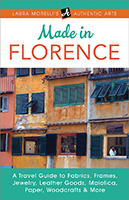
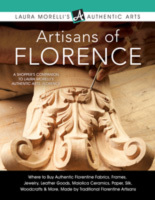
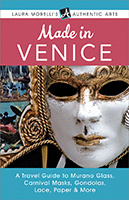
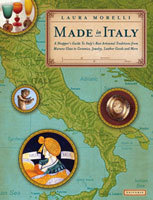
Learn more about Laura Morelli’s Authentic Arts guidebook series.
The post Violins of Cremona appeared first on Laura Morelli: Art History, Art Historical Fiction, Authentic Travel.
July 15, 2018
How to Buy Italian Silk
Many travelers to Italy count silk ties and scarves among their favorite souvenirs, and silk accessories form a kaleidoscope of color in shop windows. The beautiful lakeside city of Como has been a leader in silk-making for more than a century, supplying the fashion houses of Milan and the rest of the world with high-quality silk. However, most of Como’s silk enterprises are open to the trade only. If you want to experience the authentic heritage of Italian silk-making first-hand, head to Florence.

Medieval Origins
The piles of silk ties and scarves that fill the shop windows of Florence are vestiges of a thriving historical trade in silk, wool, and other textiles. Florence was already established as a textile town as early as the eleventh century, and by the 1300s, trade in cloth was a major part of the Florentine economy. Its merchants made a mint by doing business throughout the rest of Europe. This long history of textile trading formed the basis for the city’s preeminence in the world of modern fashion.
Although silk had been imported to Florence throughout the Middle Ages and traded far and wide by Florentine merchants, it began to be dyed and finished in the city itself by the fifteenth century. A fiscal census of 1404 lists some one hundred silk weavers in the city at that time, and silk grew in importance over the course of the 1400s. Prior to this time, goldsmiths had been involved in the making of gold and silver thread to be used in textiles, but by the 1420s the silk makers were taking this on themselves. The silk guild, or the Arte della Seta, incorporated both silk merchants as well as producers, and silk emerged as an important part of the artisanal fabric of Florence.
From the beginning, silk and other textiles were closely related to the leather trade, as they were all used to produce apparel. In addition, the same sheep hide might supply a maker of leather armor as well as a weaver. The complex Florentine guild system, or the arti, tightly regulated makers of everything from shoes, belts, purses, embroidery, hosiery, satin, taffeta, brocade, damask, velvet, and jewelry. Guild statutes controlled the production of these items and strict sumptuary laws stipulated the wearing of apparel made with them.

How Silk is Made
Silk-making traces its roots to prehistoric China. The Silk Road—a well-trodden system of ancient trade routes—eventually brought silk to Westerners hungry for these exotic luxuries. By the Middle Ages, Florentine merchants found themselves well positioned to take advantage of this international demand for silk.
Incongruously, this deluxe fabric begins with a worm, or more accurately, a caterpillar. The process starts with the careful cultivation of silkworms, species Bombyx mori, along with the mulberry bushes and trees that serve as their habitat and diet. Sericulturists spread the silkworms and fresh mulberry leaves on large trays stacked in special houses. There the silkworms feast on the leaves and produce a protein filament tightly wound into cocoons. Once completed, the cocoons are sorted and momentarily steamed, which kills the chrysalis, then boiled, which helps loosen the cocoon’s delicate filaments. Then, the filaments are “thrown,” a process in which several strands are twisted together to yield a thicker, stronger thread. The threads can then be dyed, making them ready to be woven or used in embroidery.
Initially, the Florentines imported the silkworm eggs, cocoons, and mulberry leaves from the East, using their well-connected international trade networks. As the silk industry grew toward the end of the fourteenth century, however, mulberry trees began to be cultivated across Tuscany, so the raw materials for silk making could be sourced in their own backyards. Some of the initial steps of the silk-making process—tending and reeling the cocoons, and spinning thread—were undertaken in silk workers’ homes. Weavers operated large wooden hand looms to produce bolts of silk and the dyeing took place in a process similar to that of wool. A central office organized the workers and commercialized the products. In Florence itself, silk production was destined both for apparel and accessories, as well as for textiles used in the home.

How to Buy Silk in Florence
Florence is a world fashion capital and it’s impossible to ignore the sparkling flagship stores of some of Italy’s most famous luxury brands. Closely associated with Florence, silk neckties and scarves are the bread and butter of many of these world-renowned designers. In addition, smaller Florentine boutiques do a brisk trade in silk accessories. Silk ties and scarves are durable, portable, and, if you know what you’re looking at, can be a good value for a high-quality Florentine souvenir.
Keep in mind, however, that the majority of silk ties and scarves in Florence are produced behind the scenes—perhaps in Florence or Tuscany, or in a factory far distant from the slick boutiques where they are sold. Therefore, it pays to be an educated consumer when it comes to shopping for these sought-after souvenirs, as you will not likely come face-to-face with the person who made them.
A number of synthetic fabrics can masquerade as silk, including acetate, nylon, and polyester. A scarf or tie may be composed entirely of synthetics, or may be made with a silk-synthetic blend. Be sure to examine scarves and ties carefully before buying.
Here’s what to look for:
Sheen: Genuine silk is famous for its beautiful shine. As you turn the scarf or tie over in your hand in raking light, you should be able to see different colors shine through, the result of differently colored threads used in the warp and weft.
Texture: Pure silk feels exceptionally smooth and slippery in your hands. When you rub the material vigorously between your hands, do you feel it begin to heat up? If so, it’s a good sign of authentic silk.
Weave: Most scarves and ties are machine-woven, which makes genuine silk difficult to distinguish from synthetics, because the stitching of both appear perfect to the eye. Hand-woven silk, more common in upholstery and home textiles, incorporates small imperfections, or slubs, in the weave.
Stitching: Check the stitching on the back of the tie or along the sides of the scarf. Artisanal ties will be more thickly woven, hand-folded, and hand-stitched. A high-quality scarf will have edges that have been rolled and stitched by hand in a thread that blends with the colors along the edges of the design.
Pattern: On silk, a design may be woven or printed. Many textiles for the home, such as decorative pillowcases and upholstery, are woven, sometimes on a traditional hand loom. In this case, you will see the pattern on both sides, with the underside distinguished by its slightly fuzzy appearance. In contrast, most scarves are printed using a silkscreen process using modern printing machines. The highest-quality scarves will be printed using a traditional, time-consuming process that involves pulling a different-colored screen across a metal frame by hand, building the design one color at a time.
Sound: If you rub pure silk between your fingers, it makes a distinctive crunching sound that is often described as similar to walking on freshly fallen snow.
Price: If the price is too good to be true, it isn’t real silk. Genuine silk is relatively expensive compared to synthetic imitations, often several times more.
If you’re still not sure, you can perform the “ring test.” Unless it’s exceptionally large or thickly woven, you can remove your wedding band or other ring and pull a silk scarf right through it. The scarf should glide through smoothly with no resistance. Synthetic fabrics tend to bunch or tug, making it difficult to pass them through a ring.
The definitive test of genuine silk, though, is the “burn test.” If you set the fringe or a thread of a silk scarf ablaze with a match or a lighter, you will hear it singe, then see it disintegrate into a tiny smoldering pile of fine ash, releasing an aroma akin to burnt hair. The burn test quickly unmasks plastic-smelling synthetic threads that curl or melt when burned. A silk merchant might be willing to perform this test for you, but I don’t recommend doing it in a store yourself!
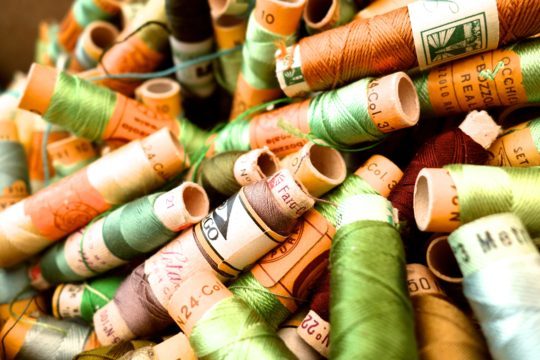
Scarfing Up an Authentic Souvenir
Sadly, foreign-made knockoffs populate many of the boutiques selling scarves across Florence. The traditional Florentine scarf is a square, with edges that have been rolled and stitched by hand. Most merchants will allow you to open and spread out a scarf to check the pattern, weave, and stitching, as well as the quality of the silk, so take the time to examine it carefully.
High-quality silk ties and scarves can be had at many small boutiques across the city although you will not necessarily see them being made. The secret to unlocking the history of Florentine silk is to explore the wonderful historical enterprises making silk fabrics, tapestry, drapery, pillow covers, bedding, and other textiles used in the home. Herein lies the opportunity to experience the centuries-old tradition of Florentine silk and wool firsthand. In fact, several Florentine textile enterprises boast pedigrees that reach back to the 1600s. Some even use generations-old handlooms to create breathtakingly beautiful fabrics whose quality is truly among the world’s finest. Best of all, you can watch it being made.
Read more about the artisanal traditions of Florence in my guide, Made in Florence.
Have you discovered Italian silk during your travels? Drop a comment below. I love to hear your stories!
.fusion-fullwidth-1 {
padding-left: 0px !important;
padding-right: 0px !important;
}
 Join me!
Join me!Be the first to receive exclusive content, news, contests, and reader appreciation gifts. Sign up for my Reader’s Group and download a free copy of my guide, How to Go Shopping on Vacation Without Getting Ripped Off.
.fusion-button.button-1 .fusion-button-text, .fusion-button.button-1 i {color:#ffffff;}.fusion-button.button-1 {border-width:0px;border-color:#ffffff;}.fusion-button.button-1 .fusion-button-icon-divider{border-color:#ffffff;}.fusion-button.button-1:hover .fusion-button-text, .fusion-button.button-1:hover i,.fusion-button.button-1:focus .fusion-button-text, .fusion-button.button-1:focus i,.fusion-button.button-1:active .fusion-button-text, .fusion-button.button-1:active{color:#000000;}.fusion-button.button-1:hover, .fusion-button.button-1:focus, .fusion-button.button-1:active{border-width:0px;border-color:#000000;}.fusion-button.button-1:hover .fusion-button-icon-divider, .fusion-button.button-1:hover .fusion-button-icon-divider, .fusion-button.button-1:active .fusion-button-icon-divider{border-color:#000000;}.fusion-button.button-1{background: #dd9933;
background-image: -webkit-gradient( linear, left bottom, left top, from( #c97800 ), to( #dd9933 ) );
background-image: -webkit-linear-gradient( bottom, #c97800, #dd9933 );
background-image: -moz-linear-gradient( bottom, #c97800, #dd9933 );
background-image: -o-linear-gradient( bottom, #c97800, #dd9933 );
background-image: linear-gradient( to top, #c97800, #dd9933 );}.fusion-button.button-1:hover,.button-1:focus,.fusion-button.button-1:active{background: #c97800;
background-image: -webkit-gradient( linear, left bottom, left top, from( #dd9933 ), to( #c97800 ) );
background-image: -webkit-linear-gradient( bottom, #dd9933, #c97800 );
background-image: -moz-linear-gradient( bottom, #dd9933, #c97800 );
background-image: -o-linear-gradient( bottom, #dd9933, #c97800 );
background-image: linear-gradient( to top, #dd9933, #c97800 );}.fusion-button.button-1{width:auto;}GET MY FREE BOOK.fusion-fullwidth-2 {
padding-left: 20px !important;
padding-right: 20px !important;
}Explore my books:




Learn more about Laura Morelli’s Authentic Arts guidebook series.
The post How to Buy Italian Silk appeared first on Laura Morelli: Art History, Art Historical Fiction, Authentic Travel.
June 16, 2018
Martorana Fruits: Sweet Treats from Sicily
Sicily is one of the world’s largest producers of almonds, with orchards dating to ancient times. Almonds form the basis for many typical Sicilian dishes, especially desserts, from almond cake (torta alla mandorla) to almond nougat (torrone or torroncino), to almond biscotti, granita, and gelato. Across Sicily, pastry shops overflow with sweet treats made from the island’s almond bounty.
Of all the island’s sweet almond treats, Martorana fruits, or frutte Martorane, take la dolce vita to a new level. Martorana fruits are not fruits at all, but masterpieces of “royal pastry” (pasta reale), a special type of marzipan. In these realistic-looking confections the artistic talents of Sicilian pastry artists truly shine.
Whether it’s the spiky stem of an eggplant, the waxy peel of a banana, or the plush skin of a peach, the tiny details of Martorana fruits are designed to trick the eye and delight the senses. It’s difficult to believe that they are made with little more than ground almonds, sugar, and a little food coloring.
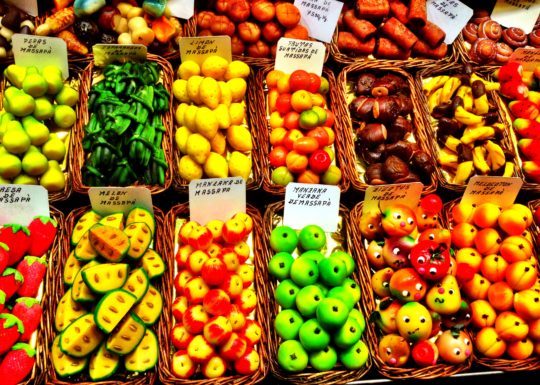
A legendary beginning
According to a story passed down over hundreds of years, these fruity-looking treats originated inside the Benedictine convent of Santa Maria dell’Ammiraglio in Palermo. The convent was commonly called La Martorana in honor of one of its twelfth-century superiors, Eloisa Martorana. Though the convent no longer exists, the beautiful church, still known as La Martorana, is one of the highlights of a visit to Palermo, with its stunning Arab-Norman architecture and mosaics.
According to the story, the nuns decorated their bare fruit trees with a bounty of realistic-looking painted fruits made of marzipan in order to impress an archbishop during his winter visit. (Many famous Italian pastries were born in convents, often the result of secret recipes passed down over generations.) The tradition eventually transcended the walls surrounding the convent orchard. During the Baroque period of the seventeenth and eighteenth centuries, people sought to create imitations of luxury items and everyday objects, and Martorana fruits found a wide audience.
Eventually, Martorana fruits came to be associated with All Soul’s Day on November 2. On that day, many Italian children still wake up to find these delectable treats at their bedsides, allegedly delivered overnight by their loving ancestors. Today, hand-decorated marzipan is closely tied to local traditions and feasts from All Soul’s Day through Easter, when pastry chefs fashion tiny lambs and eggs from pasta reale.
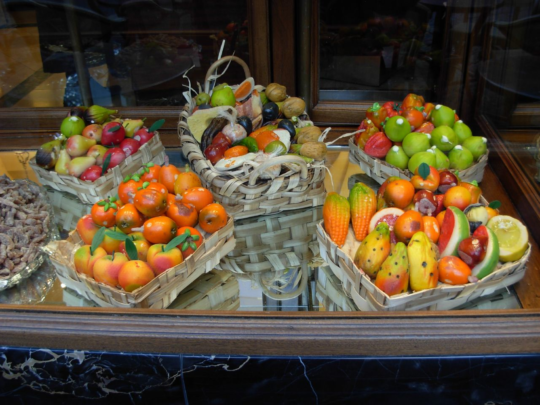
How Martorana fruits are made
Martorana fruits begin with “royal pastry,” a deceptively simple mixture of ground almonds and sugar that’s been the star of Sicilian tables since the Middle Ages. Royal pastry has a higher sugar content than regular almond paste, which makes it more pliable and easy to roll out into dough, and also malleable enough to form into infinite shapes. Some chefs include additional ingredients such as lemon, vanilla, or cinnamon, closely held as family recipes.
While some pastry artists sculpt pieces by hand, others utilize wooden or metal molds that were cast from actual fruits and vegetables. That’s how they are able to create intricate details including strawberry seeds and the puckered skin of an orange, or the rounded and cleaved form of an apricot. Typical Martorana fruits include pears, lemons, strawberries, kiwis, oranges, bananas, ears of corn, and more, but the end product is limited only by the pastry chef’s imagination. The shapes are then dried on a rack, usually overnight.
Each frutta Martorana is then hand-painted using an artist’s paintbrush with powdered food coloring mixed to the consistency of watercolor. The colors are often layered over the course of hours or sometimes days, letting each coat dry before applying the next. Many chefs finish their work with a final glaze made of gum arabic or benzoin, an edible resin that gives the confections a shiny coating.
The fun of Martorana fruits is all in the detail. Take a close look, and you’ll see everything from leaves and stems made of paper, to real watermelon seeds, papery-looking heads of garlic, and peach fuzz made of spun sugar. Let’s be honest: Some Martorana fruits look too beautiful to eat, and although they are entirely edible, they keep for a long time if you want to display them instead.
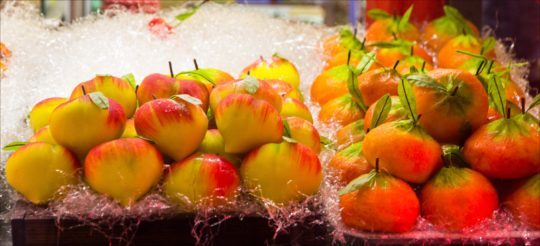
Where to sample Sicily’s best Martorana fruits
On the first Sunday in February, Agrigento hosts the Festa del Fiore del Mandorlo, when the almond blossoms first flower in the orchards. This festival celebrates the blooming of these highly valued almond trees, accompanied by song, dance, traditional costumes, and fireworks, not to mention many sweet treats made with almonds.
Traditionally, Martorana fruits make their appearance in September, when the almonds are harvested, and again in November, when they become part of the All Souls’ Day celebrations. However, today you can find Martorana fruits in many pastry shops across Sicily most of the year. In order to make sure you get a high-quality, homemade treat rather than pre-packaged version, look for the words pasticceria artigianale or produzione nostra on pastry shop windows.
Read more about Sicily’s artisanal traditions in my guide, Made in Italy.
Have you discovered Sicilian treats during your travels? Drop a comment below. I love to hear your stories!
.fusion-fullwidth-1 {
padding-left: 0px !important;
padding-right: 0px !important;
}
 Join me!
Join me!Be the first to receive exclusive content, news, contests, and reader appreciation gifts. Sign up for my Reader’s Group and download a free copy of my guide, How to Go Shopping on Vacation Without Getting Ripped Off.
.fusion-button.button-1 .fusion-button-text, .fusion-button.button-1 i {color:#ffffff;}.fusion-button.button-1 {border-width:0px;border-color:#ffffff;}.fusion-button.button-1 .fusion-button-icon-divider{border-color:#ffffff;}.fusion-button.button-1:hover .fusion-button-text, .fusion-button.button-1:hover i,.fusion-button.button-1:focus .fusion-button-text, .fusion-button.button-1:focus i,.fusion-button.button-1:active .fusion-button-text, .fusion-button.button-1:active{color:#000000;}.fusion-button.button-1:hover, .fusion-button.button-1:focus, .fusion-button.button-1:active{border-width:0px;border-color:#000000;}.fusion-button.button-1:hover .fusion-button-icon-divider, .fusion-button.button-1:hover .fusion-button-icon-divider, .fusion-button.button-1:active .fusion-button-icon-divider{border-color:#000000;}.fusion-button.button-1{background: #dd9933;
background-image: -webkit-gradient( linear, left bottom, left top, from( #c97800 ), to( #dd9933 ) );
background-image: -webkit-linear-gradient( bottom, #c97800, #dd9933 );
background-image: -moz-linear-gradient( bottom, #c97800, #dd9933 );
background-image: -o-linear-gradient( bottom, #c97800, #dd9933 );
background-image: linear-gradient( to top, #c97800, #dd9933 );}.fusion-button.button-1:hover,.button-1:focus,.fusion-button.button-1:active{background: #c97800;
background-image: -webkit-gradient( linear, left bottom, left top, from( #dd9933 ), to( #c97800 ) );
background-image: -webkit-linear-gradient( bottom, #dd9933, #c97800 );
background-image: -moz-linear-gradient( bottom, #dd9933, #c97800 );
background-image: -o-linear-gradient( bottom, #dd9933, #c97800 );
background-image: linear-gradient( to top, #dd9933, #c97800 );}.fusion-button.button-1{width:auto;}GET MY FREE BOOK.fusion-fullwidth-2 {
padding-left: 20px !important;
padding-right: 20px !important;
}Explore my books:




Learn more about Laura Morelli’s Authentic Arts guidebook series.
The post Martorana Fruits: Sweet Treats from Sicily appeared first on Laura Morelli: Art History, Art Historical Fiction, Authentic Travel.
May 15, 2018
Coral Jewelry of Naples and Torre del Greco
Italians have pulled coral and seashells from the Mediterranean and the Adriatic Seas since ancient times, using the ocean’s bounty to make some of Italy’s most beautiful adornments. The shoreline of Campania is famous for cameos and the distinctive red coral that Italian jewelers often pair with gold, pearls, and other precious materials. Alongside environmental concerns over delicate coral and reef reserves as well as initiatives to protect them, the making of jewelry and other objects from coral remains a vibrant industry in the Naples region.
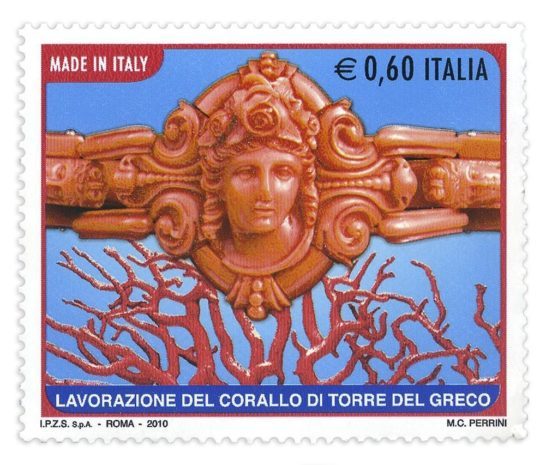
The tradition of working coral in Torre del Greco was celebrated recently on an Italian postal stamp.
Ancient origins
The history of coral ornaments and cameos stretches back to antiquity, when relief and engraved carvings on precious and semiprecious stones, shells, corals, and glass were widely admired. In Renaissance Italy, the interest in reviving antiquity brought carved corals back into vogue. Inventories, dowry lists, and other historical records of the sixteenth and seventeenth centuries tell the story of the increasing popularity of these prized objects offered as gifts, amassed in the private collections of Neapolitan aristocrats. Treasuries belonging to monasteries, convents, and other religious institutions in the Naples region counted carved corals and shells among their most prized possessions.
By 1600, fleets of coral boats called coralline sailed daily from Naples and the port of Torre del Greco to satisfy this demand for carved cameos and corals. The industry grew significant enough that coral fishermen organized themselves into a trade association and people began calling the residents of Torre del Greco themselves corallini. The boats pulled specially designed nets tacked to a wooden cross-shaped frame and dragged along the ocean bottom to gather corals and sponges. The boats were also accompanied by a few brave souls who dove in and held their breath long enough to select specimens by hand.
In 1805, a royal ornament-making enterprise called the Real Fabbrica di Coralli was established at Torre del Greco. King Ferdinand IV granted a license to Paul Barthèlemy Martin, a successful coral broker from Marseille on the coast of France, to run the establishment. Martin had the privilege of operating a ten-year coral-working monopoly, with the exclusive right to sell the factory’s production within the kingdom as well as to export it. In exchange, Martin agreed to train local craftspeople to work coral. From the beginning, the factory turned out jewelry as well as small sculptures and other art objects.
By the 1830s, some 1,800 coralline sailed from Neapolitan ports, dredging coral in the service of the Kingdom of Naples. Over the course of the nineteenth century, private coral and cameo businesses set up shop in Torre del Greco. By the twentieth century, haute jewelers around the world sought out local artisans to create signature pieces for their fashion lines. Valentino even designed a famous sandal made from coral beads wrought in Torre del Greco.

Torre del Greco
Is that legal?
In the Mediterranean Sea, the most desirable red coral, Corallum rubrum, grows between ten and three hundred meters below the surface. It does not make up part of a reef system, but rather grows in clusters along the seabed. When harvested, the shrub-like organism is composed of reddish skeletal branches covered with whitish polyps. As it dries, coral, which is composed mostly of calcium carbonate, retains its bright color and durability. Fishing for coral with nets was banned in 1994, and today only scuba divers are allowed to gather coral. While Mediterranean species are still utilized in Italian jewelry production today, increasingly Italians import Pacific red and pink species from Asia, where colonies of Corallum rubrum and other specimens are more plentiful.
Currently, red coral or Corallum rubrum is not considered an endangered species in spite of the organisms’ slow growth rate and over-harvesting in the Mediterranean. The centuries-old practice of pulling red coral from the sea, however, means that those colonies growing at the shallower depths of the Mediterranean have been largely depleted. Scientists have raised concerns about the future of Corallum rubrum because of over-extraction as well as the increasing acidification of the Mediterranean Sea in recent decades. Scientists, government bodies, and the business community are actively pursuing models of sustainable fishing for coral populations in the Mediterranean and elsewhere. Even so, it’s important to realize that worldwide, the coral population is much smaller than it was in centuries past.
Within the jewelry industry, the extraction and use of coral remains controversial. In 2002, the famous jewelry company Tiffany stopped selling coral because of environmental concerns, and many others have followed suit. For the companies in Torre del Greco, the situation is complex. Many of the town’s artisanal family enterprises stretch back generations, and discontinuing the use of coral would be a challenging economic prospect. Coral is also deeply tied to the community’s sense of self-identity, so much so that as recently as 2010 the Italian post office issued a Made in Italy stamp featuring the coral of Torre del Greco. No matter one’s stance on coral, there is no denying that this red organism defines Torre del Greco, socially, culturally, and economically. Today, the industry employs several thousand people and works with environmental groups to maintain sustainable practices as conscious stewards of this historical trade.

Buying Coral Jewelry
Jewelers have long valued coral for its beautiful color; its relative softness, which means that it can be elaborately carved; and its lustrous finish when polished. After harvesting, coral is washed and left to dry, then is sorted by color, shape, and size. The coral is cut, smoothed, and polished, then often shaped into round or oval beads, or large cabochons to be used in brooches, necklaces, and rings. Sometimes you see coral branches left in their natural form, and strung together on necklaces or used as other decoration.
Today, the port town of Torre del Greco remains the epicenter of Italian cameo production and coral jewelry making. Many of the larger producers in Torre del Greco cater to the trade only, as a thriving export business sends many of these pieces to Asia, Australia, North America, and elsewhere. Many traditional coral and cameo makers in Torre del Greco remain family affairs, some tracing their craft back generations. Parents pass the tradition to their children and grandchildren, perpetuating the techniques and the spirit of these old works. These families will almost always take the time to educate you about their techniques and history, and answer your questions.
How to Recognize Fakes
Authentic red coral of the species Corallum rubrum is precious, in short supply, and therefore expensive. Not surprisingly, fakes abound. Some jewelry and objects passed off as coral are actually made of wood, plastic, or other species of coral that are considered less desirable because of their porosity, size, form, or coloration. Bamboo coral, for example, is a beige-colored and more plentiful species that is sometimes dyed red to resemble Corallum rubrum. Much of the “coral” for sale in cheap souvenir shops around Naples are made of these imitation materials.
Authentic coral sometimes contains white flecks or small imperfections on the surface, though price is typically a better gauge. If the price seems too good to be true, chances are it’s not authentic Corallum rubrum. If you want to make sure you’re purchasing authentic red coral, buy directly from one of the makers in Torre del Greco. Alternately, if you wish to find a more sustainable solution, seek out an antique work from a reputable antiques dealer in Naples or the region.
Souvenir shops along the Amalfi and Neapolitan coasts sell junk to tourists who arrive escorted on tour buses or from cruise ships. Many of these tourist traps abound near the port of Naples and along the waterfronts of towns along the Amalfi Coast. Stick to the more well-known, reputable, and historic makers, and you’ll come home with a beautiful, high-quality souvenir you’ll treasure and proudly wear.
Resources
NAPLES
Coral Museum
Museo del Corallo Ascione
Galleria Umberto I
Piazzetta Matilde Serao, 19
081/8811165
www.museodelcorallo.it
TORRE DEL GRECO
Coral and Cameo Association
Assocoral
Associazione Produttori Coralli, Cammei e Gioielli di Torre del Greco
Via Sedivola, 28
081/0488393
www.assocoral.it
Read more about Italian coral and cameos in my guide, Made in Naples & the Amalfi Coast.
Have you discovered coral jewelry during your travels? Drop a comment below. I love to hear your stories!
.fusion-fullwidth-1 {
padding-left: 0px !important;
padding-right: 0px !important;
}
 Join me!
Join me!Be the first to receive exclusive content, news, contests, and reader appreciation gifts. Sign up for my Reader’s Group and download a free copy of my guide, How to Go Shopping on Vacation Without Getting Ripped Off.
.fusion-button.button-1 .fusion-button-text, .fusion-button.button-1 i {color:#ffffff;}.fusion-button.button-1 {border-width:0px;border-color:#ffffff;}.fusion-button.button-1 .fusion-button-icon-divider{border-color:#ffffff;}.fusion-button.button-1:hover .fusion-button-text, .fusion-button.button-1:hover i,.fusion-button.button-1:focus .fusion-button-text, .fusion-button.button-1:focus i,.fusion-button.button-1:active .fusion-button-text, .fusion-button.button-1:active{color:#000000;}.fusion-button.button-1:hover, .fusion-button.button-1:focus, .fusion-button.button-1:active{border-width:0px;border-color:#000000;}.fusion-button.button-1:hover .fusion-button-icon-divider, .fusion-button.button-1:hover .fusion-button-icon-divider, .fusion-button.button-1:active .fusion-button-icon-divider{border-color:#000000;}.fusion-button.button-1{background: #dd9933;
background-image: -webkit-gradient( linear, left bottom, left top, from( #c97800 ), to( #dd9933 ) );
background-image: -webkit-linear-gradient( bottom, #c97800, #dd9933 );
background-image: -moz-linear-gradient( bottom, #c97800, #dd9933 );
background-image: -o-linear-gradient( bottom, #c97800, #dd9933 );
background-image: linear-gradient( to top, #c97800, #dd9933 );}.fusion-button.button-1:hover,.button-1:focus,.fusion-button.button-1:active{background: #c97800;
background-image: -webkit-gradient( linear, left bottom, left top, from( #dd9933 ), to( #c97800 ) );
background-image: -webkit-linear-gradient( bottom, #dd9933, #c97800 );
background-image: -moz-linear-gradient( bottom, #dd9933, #c97800 );
background-image: -o-linear-gradient( bottom, #dd9933, #c97800 );
background-image: linear-gradient( to top, #dd9933, #c97800 );}.fusion-button.button-1{width:auto;}GET MY FREE BOOK.fusion-fullwidth-2 {
padding-left: 20px !important;
padding-right: 20px !important;
}Explore my books:




Learn more about Laura Morelli’s Authentic Arts guidebook series.
The post Coral Jewelry of Naples and Torre del Greco appeared first on Laura Morelli: Art History, Art Historical Fiction, Authentic Travel.
April 16, 2018
Ceramics of Faenza
Faenza, located in the heart of Emilia-Romagna halfway between Bologna and the Adriatic Sea, is one of Italy’s most important centers of ceramic heritage. In fact, the term faience is just a Frenchified version of Faenza, bearing witness to the importance of the town’s ceramic history. Today, Faenza’s quiet streets and idyllic squares give little witness to the powerful influence this market town once wielded. Instead, it offers a delightful, off-the-beaten-track diversion for fans of authentic Italy and ceramic tradition.

Faenza, Piazza della Libertà
What exactly is maiolica?
Maiolica refers to the technique of painting with ceramic pigments against a white glaze background over terra-cotta. Making maiolica involves layering colored pigments on top of a white glaze achieved with tin oxide. When fired in a kiln, this technique imparts brightly colored, shiny colors that pop from a creamy, opaque background. This bold contrast of color against the white, along with characteristic stylistic conventions based on a visual vocabulary of the Italian Renaissance, first propelled this type of ceramic ware to fame and keeps it popular even by today’s standards of taste.

Pharmacy jar or “albarello” from Faenza, now in the Metropolitan Museum of Art, NYC (CC courtesy Met Museum)
In Faenza, the maiolica tradition began during the Middle Ages. By the 1500s, Faenza was famous for its annual weeklong fiera, which drew merchants and crowds from across Europe to trade everything from sheep to the region’s famous cheeses and cured ham. By that time, ceramicists in Faenza were already major producers and exporters of colorful ceramic wares.
Maiolica was popular with the noble classes for decorating fine homes throughout Italy during the Renaissance and Baroque periods. Pieces of maiolica were exchanged between acquaintances, and special pieces were commissioned to mark engagements, important political or business alliances between families, and other special occasions. Wealthy patrons tasked ceramics masters with creating “his-and-hers” plates depicting the elegant profiles of a bride and groom. They covered their tables with brightly painted wares depicting themes of hunting, mythology, and heraldry.
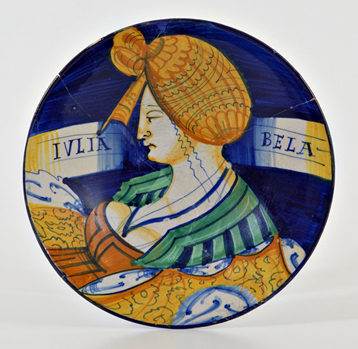
“Beautiful Giulia” plate
Faenza styles
Faenza became known for its “beautiful lady” plates, popular in the Renaissance as engagement and marriage gifts. Alongside a profile of a lovely female, the name of the lady—Bella Giulia for example—would be painted on a scroll. Today’s Faenza’s artisans make lovely reproductions of these beautiful lady plates, along with many other works— bells shaped like women with long dresses, small plates, pharmacy jars, eggs, Christmas ornaments, oil and vinegar jars, and many other small treasures.
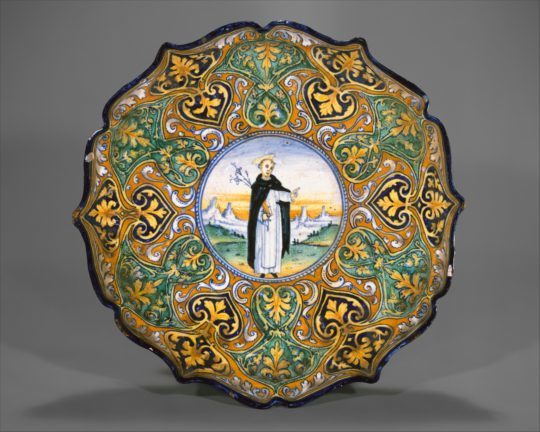
“Crespina” dish, ca. 1480, now in the Metropolitan Museum of Art, NYC (CC courtesy Met Museum)
There’s no single style of Faenza ceramics, but today artisans who follow historical tradition take their inspiration from one or more of the main ceramic periods of Faenza:
stile arcaico (archaic style): This is the monochromatic style of the Middle Ages, with dark blue geometric patterns against a white ground.
stile severo (severe style): This is the quintessential Renaissance style, with noblewomen shown in profile and symmetrical decorative motifs in the form of leaves and peacock feathers. Blue, gold, and ochre predominate.
stile bello (beautiful style): Storytelling or “historiated” pottery became all the rage in the 1500s, with religious and mythological scenes covering an entire plate or vessel.
stile compendiario (abbreviated style): Not much painted decoration here, it’s true, but the artisans more than make up for it with elaborate basket patterns and pierced effects through the white glaze.
stile Berettino (Berettino style): This refers to a rich decoration of white scrollwork against a dark blue ground.
stile a garofano (carnation style): Carnations and other flowers characterize this type of decoration, and blues, greens, and ochres predominate. The style was influenced by French and Asian pottery popular in the eighteenth and nineteenth centuries.
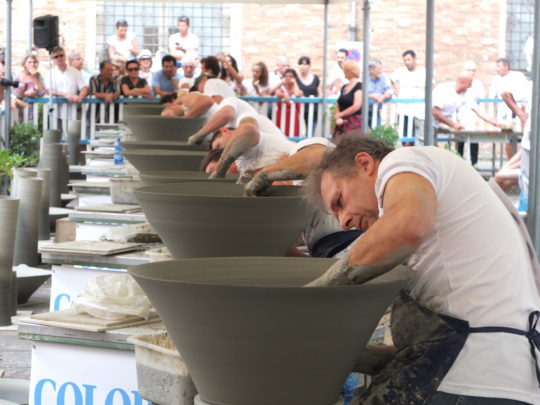
Faenza ceramics festival (CC courtesy Argilia Italia)
Shopping in Faenza
Today Faenza is home to several dozen working ceramics firms whose artisans quietly turn out small masterpieces. Quality and price vary tremendously in Faenza, but in general, you can find good values on ceramics given that the town is off the beaten tourist track. You can purchase a high-quality, authentic work directly from one of Faenza’s ceramic masters for less than a hundred Euro. These pieces hold their value over time; authentic works produced in Faenza between 1500 and 1530 often command six figures at auction.
In recent years the Italian Association of Ceramic Cities (the Associazione Italiana Città Ceramiche, or AICC) has invented trademarks to designate ceramics that adhere to certain historical standards, much as the term D.O.C. is given to wines that follow standards for a particular region. In Faenza, this “ceramic D.O.C.” is a trademark with an image of a handshake, one of the traditional decorative motifs of Faenza ceramics. Look for it prominently displayed at the entrance to the town’s ceramic merchants that have earned this designation.
If you want to shop Faenza like the locals, rent or borrow a bicycle; it’s the way most people get around this small, flat town. Start with the ceramics museum—one of the best in Italy—to get an overview of Faenza’s impressive heritage of working clay.
Don’t miss…
Ceramics Museum
Museo Internazionale della Ceramica
Viale Baccarini, 19
0546/697311
La Nott de Bisò
First Saturday in January
Roughly translated from the local dialect as “wine night,” this rowdy event culminates in the liberal pouring of local wines from pitchers made of Faenza ceramics.
Festa della Ceramica
June
Faenza’s summer ceramics festival showcases the city’s best artisans. The first week of the festival kicks off Niballo, a medieval jousting tournament in which the winner receives a ceramic trophy.
Read more about Faenza ceramics in my guide, Made in Italy.
Have you discovered Italian ceramics during your travels? Drop a comment below. I love to hear your stories!
.fusion-fullwidth-1 {
padding-left: 0px !important;
padding-right: 0px !important;
}
 Join me!
Join me!Be the first to receive exclusive content, news, contests, and reader appreciation gifts. Sign up for my Reader’s Group and download a free copy of my guide, How to Go Shopping on Vacation Without Getting Ripped Off.
.fusion-button.button-1 .fusion-button-text, .fusion-button.button-1 i {color:#ffffff;}.fusion-button.button-1 {border-width:0px;border-color:#ffffff;}.fusion-button.button-1 .fusion-button-icon-divider{border-color:#ffffff;}.fusion-button.button-1:hover .fusion-button-text, .fusion-button.button-1:hover i,.fusion-button.button-1:focus .fusion-button-text, .fusion-button.button-1:focus i,.fusion-button.button-1:active .fusion-button-text, .fusion-button.button-1:active{color:#000000;}.fusion-button.button-1:hover, .fusion-button.button-1:focus, .fusion-button.button-1:active{border-width:0px;border-color:#000000;}.fusion-button.button-1:hover .fusion-button-icon-divider, .fusion-button.button-1:hover .fusion-button-icon-divider, .fusion-button.button-1:active .fusion-button-icon-divider{border-color:#000000;}.fusion-button.button-1{background: #dd9933;
background-image: -webkit-gradient( linear, left bottom, left top, from( #c97800 ), to( #dd9933 ) );
background-image: -webkit-linear-gradient( bottom, #c97800, #dd9933 );
background-image: -moz-linear-gradient( bottom, #c97800, #dd9933 );
background-image: -o-linear-gradient( bottom, #c97800, #dd9933 );
background-image: linear-gradient( to top, #c97800, #dd9933 );}.fusion-button.button-1:hover,.button-1:focus,.fusion-button.button-1:active{background: #c97800;
background-image: -webkit-gradient( linear, left bottom, left top, from( #dd9933 ), to( #c97800 ) );
background-image: -webkit-linear-gradient( bottom, #dd9933, #c97800 );
background-image: -moz-linear-gradient( bottom, #dd9933, #c97800 );
background-image: -o-linear-gradient( bottom, #dd9933, #c97800 );
background-image: linear-gradient( to top, #dd9933, #c97800 );}.fusion-button.button-1{width:auto;}GET MY FREE BOOK.fusion-fullwidth-2 {
padding-left: 20px !important;
padding-right: 20px !important;
}Explore my books:




Learn more about Laura Morelli’s Authentic Arts guidebook series.
The post Ceramics of Faenza appeared first on Laura Morelli: Art History, Art Historical Fiction, Authentic Travel.
March 15, 2018
Bagpipes of Scapoli
For people like me with a passion for traditional cultures, Abruzzo and Molise are among Italy’s most interesting regions. These rural communities—cut off from the rest of the Italian peninsula by formidable mountains—remain a secret for most international visitors. Travelers intrepid enough to veer off the beaten path are rewarded with a rich tapestry of traditional Italian crafts: lace, wrought iron, gold, ceramics, and most surprising of all—bagpipes.
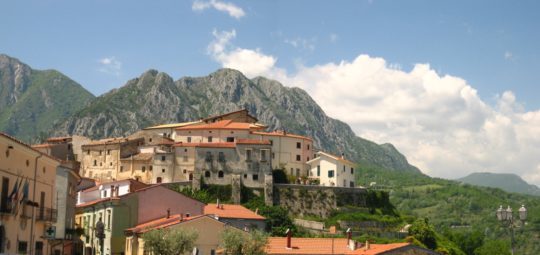
Scapoli CC (c) Fatboo via Flickr
Bagpipes? Seriously?
It’s not what you’d expect to find in Italy, but some argue that the zampogna made in Scapoli—a mountain village of rural Molise–is the ancient ancestor of the Scottish instrument, allegedly introduced to Scotland by Roman soldiers. Centuries ago, bagpipes filled the air across Italy with their eerie, solemn cries, but today, Scapoli is one of the only towns in the country that preserves this ancient tradition.
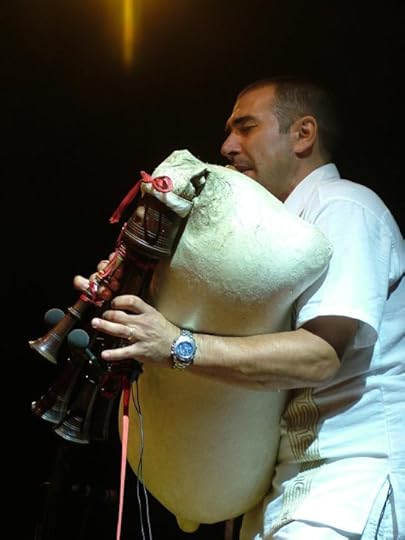
CC (c) Lucio Musacchio via Flickr
No one knows when locals began making these strange instruments, but their origins surely reach back into antiquity. Just a half-century ago, nearly 20,000 sheep grazed the mountain grasslands outside of Scapoli, providing skins for making bagpipes. They formed a quiet audience for the shepherd who heard his own haunting melodies repeated back to him as echoes off the mountain walls. Today, few herds dot the verdant hillsides, and the zampogna is played mostly at festival times.
The Scapoli bagpipe is a type known as a double-chanter, with two sets of finger holes for producing its distinctive sounds. The instrument is a complicated contraption made of sheepskin bags, pipes of cherry or olive wood, and reeds made of cane. A handful of artisans residing in the Fontecostanza section of Scapoli preserve and pass on the ancient tradition and techniques for making these instruments.
Festival Internazionale della Zampogna
Three days in late July transform the normally quiet town of Scapoli into a noisy cacophony of sound with an international bagpipe festival. The eerie sounds of the zampognari playing these wind instruments–combining wood, sheepskin, and metal—fill the air, and demonstrations of artisanal techniques provide a unique look at this ancient craft. Local culinary specialties, like goat’s cheese and black olives, complete the event.
Vico Santa Maria, 1
86070 Scapoli (IS)
0865/954270
At other times of the year, start your visit at the Museo della Zampogna in Scapoli to learn more about this ancient instrument. If you want to take one home, prices for Scapoli bagpipes run between 200 and 1000 Euro, depending on how they are outfitted, what types of wood are utilized, and their decoration.
Read more about Italian bagpipes in my guide, Made in Italy.
Have you discovered bagpipes during your travels? Drop a comment below. I love to hear your stories!
.fusion-fullwidth-1 {
padding-left: 0px !important;
padding-right: 0px !important;
}
 Join me!
Join me!Be the first to receive exclusive content, news, contests, and reader appreciation gifts. Sign up for my Reader’s Group and download a free copy of my guide, How to Go Shopping on Vacation Without Getting Ripped Off.
.fusion-button.button-1 .fusion-button-text, .fusion-button.button-1 i {color:#ffffff;}.fusion-button.button-1 {border-width:0px;border-color:#ffffff;}.fusion-button.button-1 .fusion-button-icon-divider{border-color:#ffffff;}.fusion-button.button-1:hover .fusion-button-text, .fusion-button.button-1:hover i,.fusion-button.button-1:focus .fusion-button-text, .fusion-button.button-1:focus i,.fusion-button.button-1:active .fusion-button-text, .fusion-button.button-1:active{color:#000000;}.fusion-button.button-1:hover, .fusion-button.button-1:focus, .fusion-button.button-1:active{border-width:0px;border-color:#000000;}.fusion-button.button-1:hover .fusion-button-icon-divider, .fusion-button.button-1:hover .fusion-button-icon-divider, .fusion-button.button-1:active .fusion-button-icon-divider{border-color:#000000;}.fusion-button.button-1{background: #dd9933;
background-image: -webkit-gradient( linear, left bottom, left top, from( #c97800 ), to( #dd9933 ) );
background-image: -webkit-linear-gradient( bottom, #c97800, #dd9933 );
background-image: -moz-linear-gradient( bottom, #c97800, #dd9933 );
background-image: -o-linear-gradient( bottom, #c97800, #dd9933 );
background-image: linear-gradient( to top, #c97800, #dd9933 );}.fusion-button.button-1:hover,.button-1:focus,.fusion-button.button-1:active{background: #c97800;
background-image: -webkit-gradient( linear, left bottom, left top, from( #dd9933 ), to( #c97800 ) );
background-image: -webkit-linear-gradient( bottom, #dd9933, #c97800 );
background-image: -moz-linear-gradient( bottom, #dd9933, #c97800 );
background-image: -o-linear-gradient( bottom, #dd9933, #c97800 );
background-image: linear-gradient( to top, #dd9933, #c97800 );}.fusion-button.button-1{width:auto;}GET MY FREE BOOK.fusion-fullwidth-2 {
padding-left: 20px !important;
padding-right: 20px !important;
}Explore my books:




Learn more about Laura Morelli’s Authentic Arts guidebook series.
The post Bagpipes of Scapoli appeared first on Laura Morelli: Art History, Art Historical Fiction, Authentic Travel.
February 15, 2018
Ceramics of Castelli in Abruzzo
Castelli is considered one of Italy’s grand ceramic traditions, and examples of these colorful wares are prized in the collections of the Metropolitan Museum in New York, the Louvre in Paris, and other international museums.

Pharmacy jar from Castelli, CC courtesy Metropolitan Museum, NYC
It all began during the Middle Ages, when the Benedictine monks of San Salvatore of Castelli in Abruzzo began teaching locals how to pull clay from the mountains, and turn it into decorated pottery. By the 1500s, Castelli was producing a large volume of maiolica, ceramics bathed in a tin-based, opaque white glaze and then painted with bright colors. Some of these early ceramic artisans used the whole town as their canvas. The ceiling of the church of San Donato in Castelli is paved with ceramic bricks from the fifteenth and sixteenth centuries. Ceramic altarpieces, fonts, and street-side ex votos display saints and Madonnas painted by artisans of Castelli’s most important ceramic dynasties: the Pompei, Grue, Gentili, Cappelletti, de Martinis, and Fuina.
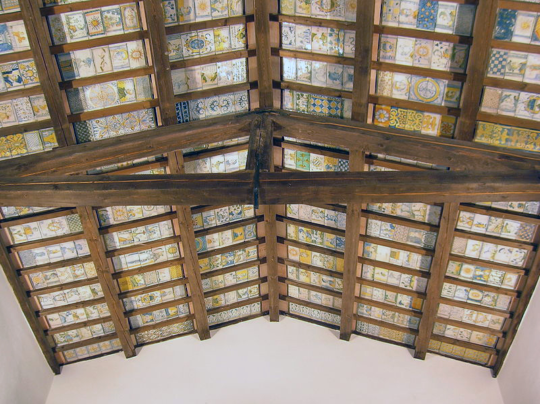
Even the ceiling of Castelli’s San Donato church is covered in ceramic tiles!
In the 1500s, Castelli’s artisans were commissioned to create a set of maiolica vessels to celebrate peace between the Orisini and Colonna families. These wares—bulbous vases and jars with handles, and busts of noblemen and women—inspired many imitators. Their bell-shaped vases, pot-bellied jugs, and flasks with large handles stood alongside those of other Italian ceramics centers like Deruta and Faenza. The ceramics of Castelli began to be widely exported outside of the Italian peninsula as luxury items.

Plate from Castelli, CC courtesy Metropolitan Museum of Art, NYC
Some time in the 1600s, Castelli departed from the traditional patterns and styles that made other ceramics towns famous, and the town made a name for itself with “historiated,” or story-telling ceramics decorated with popular scenes from religion and mythology. Watercolor-like landscapes that treated the white glaze like a blank canvas also delighted the noble classes who consumed these pieces. Today, several dozen artisan enterprises in Castelli continue the centuries-old tradition of making these colorful wares.
Today, many of Castelli’s some fifty ceramic enterprises snake along the Via Scesa del Borgo and cluster around the artisan district known as the Villaggio Artigiano. Electric potters’ wheels and gas-fired kilns have replaced the manual tasks that were central to Castelli’s ceramic techniques for centuries, but the best artisans still capture the historical styles and spirit that characterize this grand tradition. The Ceramics Museum is a great place to start your visit, and if you want to learn how to make Castelli ceramics yourself, check out the school dedicated to the town’s craft:
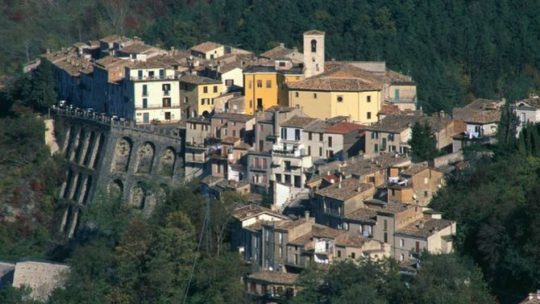
Castelli in Abruzzo
Ceramics Museum
Museo delle Ceramiche
Salita Paradiso
64041 Castelli (TE)
0861/970725
Ceramics School
Istituto d’Arte per la Ceramica “Grue”
Via Convento
64041 Castelli (TE)
0861/979221
Read more about Castelli ceramics in my guide, Made in Italy.
Have you discovered Italian ceramics during your travels? Drop a comment below. I love to hear your stories!
.fusion-fullwidth-1 {
padding-left: 0px !important;
padding-right: 0px !important;
}
 Join me!
Join me!Be the first to receive exclusive content, news, contests, and reader appreciation gifts. Sign up for my Reader’s Group and download a free copy of my guide, How to Go Shopping on Vacation Without Getting Ripped Off.
.fusion-button.button-1 .fusion-button-text, .fusion-button.button-1 i {color:#ffffff;}.fusion-button.button-1 {border-width:0px;border-color:#ffffff;}.fusion-button.button-1 .fusion-button-icon-divider{border-color:#ffffff;}.fusion-button.button-1:hover .fusion-button-text, .fusion-button.button-1:hover i,.fusion-button.button-1:focus .fusion-button-text, .fusion-button.button-1:focus i,.fusion-button.button-1:active .fusion-button-text, .fusion-button.button-1:active{color:#000000;}.fusion-button.button-1:hover, .fusion-button.button-1:focus, .fusion-button.button-1:active{border-width:0px;border-color:#000000;}.fusion-button.button-1:hover .fusion-button-icon-divider, .fusion-button.button-1:hover .fusion-button-icon-divider, .fusion-button.button-1:active .fusion-button-icon-divider{border-color:#000000;}.fusion-button.button-1{background: #dd9933;
background-image: -webkit-gradient( linear, left bottom, left top, from( #c97800 ), to( #dd9933 ) );
background-image: -webkit-linear-gradient( bottom, #c97800, #dd9933 );
background-image: -moz-linear-gradient( bottom, #c97800, #dd9933 );
background-image: -o-linear-gradient( bottom, #c97800, #dd9933 );
background-image: linear-gradient( to top, #c97800, #dd9933 );}.fusion-button.button-1:hover,.button-1:focus,.fusion-button.button-1:active{background: #c97800;
background-image: -webkit-gradient( linear, left bottom, left top, from( #dd9933 ), to( #c97800 ) );
background-image: -webkit-linear-gradient( bottom, #dd9933, #c97800 );
background-image: -moz-linear-gradient( bottom, #dd9933, #c97800 );
background-image: -o-linear-gradient( bottom, #dd9933, #c97800 );
background-image: linear-gradient( to top, #dd9933, #c97800 );}.fusion-button.button-1{width:auto;}GET MY FREE BOOK.fusion-fullwidth-2 {
padding-left: 20px !important;
padding-right: 20px !important;
}Explore my books:




Learn more about Laura Morelli’s Authentic Arts guidebook series.
The post Ceramics of Castelli in Abruzzo appeared first on Laura Morelli: Art History, Art Historical Fiction, Authentic Travel.
January 14, 2018
The Laura Morelli Amazon Store Is Open for Business!

Amazon recently sent me an email saying that because they had identified me as an “influencer,” they were offering me a Laura Morelli Store on Amazon.com! Everyone who emails me to let me know how much they love Italian style, art, fine food and drink, and a home filled with creature comforts, can now find many things I love in my very own Amazon store.

There are lots of authentic “Made in Italy” items in my Amazon store. Check it out!
Where can I find…
From the espresso maker I use, to my go-to reading glasses, favorite comfy chair, home accessories, and favorite Parisian tea, you can find many of the things I love in my Amazon store. There are lots of art books (surprise!) and also some of my favorite office and kitchen tools.
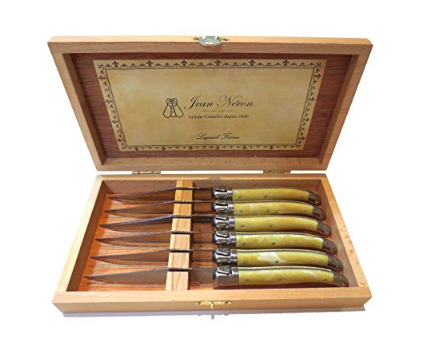
Need a gift idea? Check out my suggestions!
As an author of shopping guidebooks, collecting beautiful things has always been an occupational hazard for me. And as an introvert and work-at-home junkie, online shopping is one of my favorite pastimes. I love Amazon for the huge variety and convenience of shopping online. I’ve had a blast curating some of my favorite things all in one place.
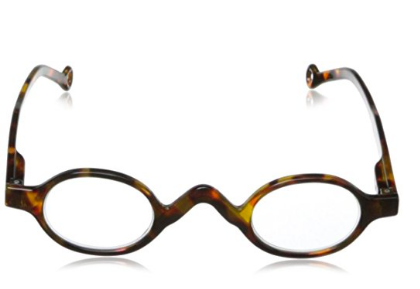
My favorite reading glasses… I have about 10 pair scattered around my house. Check them out in my Amazon store!
In short, my Amazon store is like a style board for my life. Some of the items in my shop are expensive, others very affordable, still others in between. I hope you have fun browsing my store. My greatest wish is that you find something that speaks to you, something that enhances your life in some small way!
What would you like to see in my Amazon store? Comment below!
[/fusion_text].fusion-fullwidth-1 {
padding-left: 0px !important;
padding-right: 0px !important;
}
 Join me!
Join me!.fusion-button.button-1 .fusion-button-text, .fusion-button.button-1 i {color:#ffffff;}.fusion-button.button-1 {border-width:0px;border-color:#ffffff;}.fusion-button.button-1 .fusion-button-icon-divider{border-color:#ffffff;}.fusion-button.button-1:hover .fusion-button-text, .fusion-button.button-1:hover i,.fusion-button.button-1:focus .fusion-button-text, .fusion-button.button-1:focus i,.fusion-button.button-1:active .fusion-button-text, .fusion-button.button-1:active{color:#000000;}.fusion-button.button-1:hover, .fusion-button.button-1:focus, .fusion-button.button-1:active{border-width:0px;border-color:#000000;}.fusion-button.button-1:hover .fusion-button-icon-divider, .fusion-button.button-1:hover .fusion-button-icon-divider, .fusion-button.button-1:active .fusion-button-icon-divider{border-color:#000000;}.fusion-button.button-1{background: #dd9933;
background-image: -webkit-gradient( linear, left bottom, left top, from( #c97800 ), to( #dd9933 ) );
background-image: -webkit-linear-gradient( bottom, #c97800, #dd9933 );
background-image: -moz-linear-gradient( bottom, #c97800, #dd9933 );
background-image: -o-linear-gradient( bottom, #c97800, #dd9933 );
background-image: linear-gradient( to top, #c97800, #dd9933 );}.fusion-button.button-1:hover,.button-1:focus,.fusion-button.button-1:active{background: #c97800;
background-image: -webkit-gradient( linear, left bottom, left top, from( #dd9933 ), to( #c97800 ) );
background-image: -webkit-linear-gradient( bottom, #dd9933, #c97800 );
background-image: -moz-linear-gradient( bottom, #dd9933, #c97800 );
background-image: -o-linear-gradient( bottom, #dd9933, #c97800 );
background-image: linear-gradient( to top, #dd9933, #c97800 );}GET MY FREE BOOK.fusion-fullwidth-2 {
padding-left: 20px !important;
padding-right: 20px !important;
}Explore my books:
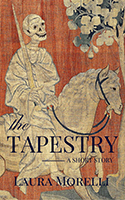
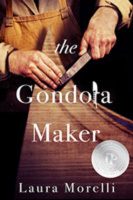

 Learn more about Laura Morelli’s Authentic Arts guidebook series.
Learn more about Laura Morelli’s Authentic Arts guidebook series. The post The Laura Morelli Amazon Store Is Open for Business! appeared first on Laura Morelli: Art History, Art Historical Fiction, Authentic Travel.






